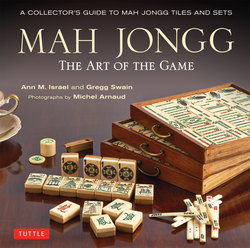Читать книгу Mah Jongg: The Art of the Game - Gregg Swain - Страница 10
Оглавление| CHAPTER 3 Paper Mah Jongg Sets |
Mah Jongg began as a paper game from the ancient Chinese card game Ma Taio, but as it caught on in the early twentieth century a “paper” Mah Jongg set came to mean a deck of playing cards, or simply cardboard squares where each individual piece mimicked a specific Mah Jongg tile. While such sets were generally considered as novel, they were also a lot cheaper and more portable than their more durable bone, bamboo, and Bakelite cousins. And, unlike those tiles where images were limited by the process of carving or stamping into a hard material, the designs on paper Mah Jongg sets were limited only by the imagination of the printer or designer.
England had two major manufacturers of paper Mah Jongg games. The first was Chad Valley, a toy manufacturer that made decks of cards whose suits were vibrant and colorful, especially the Dragons. But it is the set by card maker Thomas de la Rue of London that can be argued is the apotheosis of Mah Jongg design. Their “Electrical Mah Jong” deck, commissioned by the Western Electric Company Ltd, extolled the marvels of electrical utilities for the 1924 British Empire Exhibition. On beautifully laminated gold-edged cards, flamenco dancers and Eskimos share a deck featuring vacuum tubes as Bams and wire cables as Dots. Flowers recount the evolution of telephony. It is a masterpiece of artistry for a paper Mah Jongg set.
Many early paper examples, such as the Deshler set from Shanghai, are shaped like Ma Taio cards, whose thin vertical format was already known to the Chinese. The unusual looking set by Golconda also shares that format, telling an ancient Chinese story on lithographed paper with far more detail than could be told on Bakelite or Bone.
This Craftmaster cardboard set resembles folk art. It came with Wind indicators, racks, and dice. The counting sticks have unusual designs, with stripes instead of dots.
Chad Valley, the British toy maker, made this brightly colored paper set.
Right Golconda cards, with characters from the historical novel Romance of the Three Kingdoms, have highly detailed illustrations. Note the soaring bird One Bam in the top row, second from right.
Deshler’s paper set came in this charming box, its lid illustrated with a family playing the game. The East position is indicated at the top of the box.
This wonderful traveling leather set by London card maker Thomas de la Rue is enhanced with a gold-embossed Art Deco logo. The color red denotes good luck.
Printed by Thomas de la Rue in 1924, “Electrical Mah Jong” is one of the most beloved versions of the game. The cards have distinctly modern designs, with telephones as Craks, radios as Bams, and cables as Dots. Winds are illustrated by “inhabitants” of the four cardinal directions: North, an Eskimo; South, a flamenco dancer; East, a Chinese man; and West, a Briton complete with bad weather and brolly. Red Dragons are Aerials, Green are Earth, and White are Ether. Flowers illustrate four telephones in Western Electric’s history.
For this “Man-Chu” set, made by the US Playing Card Company in Cincinnati, its art department pulled out all stops to conjure up the Exotic East, from the dragon on the box to the typography to the cards themselves. Robert Foster, one of the early authorities on Mah Jongg, wrote the rule book.
